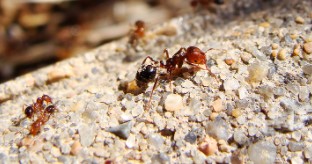By Mary Hightower
Fast facts:
- Loftin: Imported fire ants, of tropical origin, may see population shrink temporarily
- Thrash: Redbanded, southern green stinkbugs likely affected by cold
A week of record-low temperatures may leave its mark on Arkansas’ fire ant populations, but don’t look for the cold to have reduced fly or tick numbers, Kelly Loftin, extension entomologist for the University of Arkansas System Division of Agriculture, said Friday.

FIRE ANTS — The extreme cold of the winter of 2021 may make a dent in fire ant populations in Arkansas.
In general, Loftin said that “insects that are endemic to our region have evolved various mechanisms to survive cold winters.” However, invasives that originate from warmer climates don’t have those means for survival.
Fire ants and freezing weather
“Imported fire ants are a good example of an exotic species that can be adversely impacted by extreme cold temperatures,” he said. “This pest ant has expanded its range about as far north as it can under normal winter conditions. And north Arkansas is the northern limit of its range.
“Although imported fire ants are native to South America, they survive most Arkansas winters,” Loftin said. “However sustained cold can cause a temporary population reduction.”
He said that a decade ago, when parts of the state sustained seven days below freezing, “Arkansas’ fire ant population experienced a 70 percent reduction in the number of fire ant colonies.” he said.
But you can’t keep fire ants down for long.
“About 1.5 years later, fire ants returned to the prior population level,” he said. “Fire ant colonies associated with sidewalks, parking lots, foundations, and other areas tend to survive simply because these structures serve as heat sumps thus preventing colonies from freezing.”
Ticks
Ticks are pretty good at finding protected places to ride out the freezing weather.
“Species such as the American dog tick and lone star tick survive the winter by seeking shelter as adults and nymphs in the leaf litter,” Loftin said. “Other species such as the winter tick are attached to a warm host during the cold winter.”
“If you look at the geographical range of the American dog tick, black-legged tick and winter tick, all three survive up to the Canadian border and beyond,” he said. “Even the lone star tick survives up to the Great Lakes region.”
Loftin said temperatures will influence when ticks become active.
“For example, if we have a warm spring, we will see active ticks in March or April,” he said. “And during warm spells during winter months you may see an occasional active lone star or American dog tick in January or February. Likewise if temperature remain cold in the spring, ticks will not become active as early.”
Flies
Don’t count on a week of freezing temperatures to knock out flies.
“The house fly range is worldwide including the Arctic, so obviously we wouldn’t expect to see much winter mortality,” Lofton said, adding that “our most important livestock flies have different mechanisms to survive cold winters.
House flies and horn flies of cattle survive cold temperatures as larva or pupae under manure piles and other protected breeding material.
The face fly a pest with a different overwintering strategy as a hibernating adult. Introduced from Europe into Nova Scotia, Canada, about 1950, face flies hibernate in church steeples, attics, barns and other protected areas.
“I routinely see hibernating face flies on warm days in manmade structures,” Loftin said. “Many times they are numerous enough to become household pests.”
Row crop pests
The effects of the deep freeze are uncertain, said Ben Thrash, extension entomologist for the Division of Agriculture.
“We can safely say the redbanded stink bugs and southern green stink bugs will be knocked back for the next several years,” he said. “I think many our native species will be relatively unaffected.”
However, the cold’s effects on insects that migrate to Arkansas isn’t known yet.
“Insects like corn earworm and fall armyworms do overwinter here Arkansas, the cold should have killed them here, but many of our most damaging corn earworm populations migrate from places like the lower Rio Grande Valley in Texas and south Louisiana,” Thrash said. “I’d bet we will still see these insects, but they may just be delayed in getting here.”
“I would like to put some data together sometime to see if there are any trends I can pick out with weather and certain species,” he said. “Other things like how wet our spring is can also have major effects on our insect populations by promoting weed growth.”
Thrash recalled something former Arkansas soybean breeder Chuck Caviness said when asked to predict a field’s soybean field. Caviness declared “Only fools and newcomers try to predict soybean yield, and I’m neither.”
Thrash said, “I’m beginning to feel the same way about predicting insect numbers.”
Source : uaex.edu